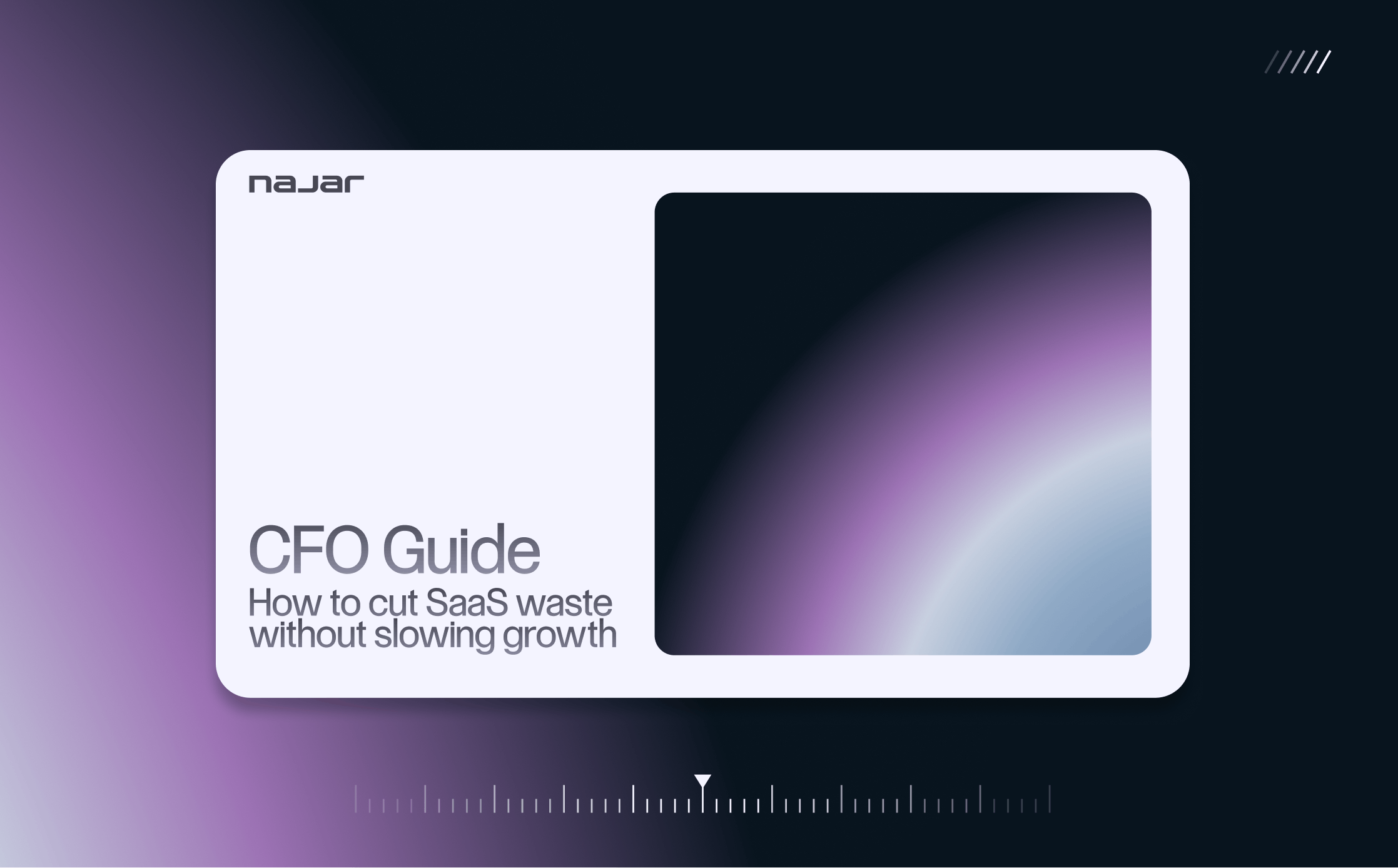In the current context of shrinking markets, some companies are finding their access to financing restricted. But one sector has proved more than resilient: Software-as-a-service, or SaaS.
SaaS is a method of supplying software that uses cloud computing. Instead of downloading and installing software on a local computer, a SaaS, such as Slack or Salesforce, allows end-users to access a cloud application via a web browser. A procurement team, on the other hand, is responsible for managing purchasing and supply within an organization.
These methods offer a number of advantages, including lower costs, streamlined production processes and greater security than traditional software, ultimately improving companies' overall operational efficiency.
When should your organization set up a procurement team and/or an efficient system for managing SaaS tools? There are a number of indicators that can help you determine whether this need is present in your company, and to what degree.
Why are Procurement teams and SaaS solutions becoming more crucial?
The widespread use of procurement teams and SaaS solutions is on the increase worldwide. A Research Report World study published in June 2023 shows that the global Software as a Service (SaaS) market is expected to grow at a CAGR of 30% between 2023 and 2030.
SaaS solutions are contributing to organizational transformation in the current context of digital transition, where traditional solutions are gradually being abandoned by companies in favour of cloud-based solutions. The pandemic has also had an impact on SaaS solutions, as demonstrated by the widespread use of the Zoom platform.
Having a procurement team enables a given company to identify potential sources of savings. For example, this team can negotiate advantageous contracts and rates with the company's various suppliers, optimize licenses and subscriptions or monitor SaaS-related expenses.
It should be noted, however, that there are challenges associated with SaaS, identified in a 2023 Flexera study: security, expenses and expertise. Procurement teams, therefore, play a key role in selecting the suppliers best suited to the company's needs.
How to determine whether you need a procurement team
There are a number of key indicators that can help you determine whether your company needs a procurement team.
Inadequate contract management
Ineffective management of contracts (customers, suppliers, leases, etc.) can have a negative impact on your company's growth.
When contract renewal dates are missed, operational disruptions can occur, as can loss of access to essential software or service interruptions. By setting up a dedicated procurement team, you no longer risk missing contract renewal dates.
You also avoid the penalties that can arise from poor contract management, resulting in avoidable costs for your business.
You also guard against risks associated with poor management of company resources, legal risks - if contractual clauses are misinterpreted - or a loss of customer confidence due to ineffective contract management.
Lack of monitoring of your software
Poor management or irregular monitoring of the use of the various software packages in place within the organization can have negative consequences for your company's performance.
A software inventory that isn't carried out regularly could lead you to pay for licenses that aren't being used, thereby generating avoidable costs for your company. You could also miss out on opportunities to negotiate advantageous contracts.
Having several similar software tools performing the same tasks can undermine employee productivity and waste resources.
Other risks can also arise, such as data security, operational inefficiencies and software compliance issues.
Ineffective negotiations with suppliers
Unsuccessful negotiations can lead to excessive costs for your company. For example, if negotiations are not conducted fairly and transparently with your supplier, they can lead to frustration and the risk of a breakdown in your supply chain.
Contractual conditions that are not clearly defined could mean not being able to deliver the required products or services on time.
Other risks to your company's competitiveness may arise, such as a lack of innovation or added value in your product, or poor-quality products.
How a procurement team can solve these problems
If you've already encountered any of the above problems, enlisting the help of a procurement team can improve your company's competitiveness and enable you to focus on the essential tasks linked to your business.
Here's how:
- If your contracts aren't being managed properly, a procurement team could help you establish a clear process for defining contracts, and track important deadlines so you don't miss a contract's renewal date. The implementation of a centralized software platform by the procurement team could help you track renewal dates or contractual clauses.
- If your software lacks optimization, a procurement team could help your team to carry out an inventory of the software used within your company, or analyze actual usage to identify redundancies. It can also negotiate preferential rates with suppliers: for example, by consolidating Microsoft Office license purchases across the company, a more advantageous overall price can be negotiated.
- Finally, if negotiations with your supplier are not optimal, a procurement team can help you set up a structured negotiation process by conducting in-depth research into the offer and defining clear negotiation objectives. The procurement team can help you implement penalties for failure to meet commitments.
Identify your SaaS inventory needs
Certain key indicators can help you recognize a need for support in optimising your SaaS tools.
Challenges related to shadow IT
Shadow IT refers to the use of software, technology or IT services by employees without the approval of the company's IT department. The use of cloud services that do not comply with corporate standards can have harmful consequences.
How can this happen? Unregulated SaaS use can lead to security risks. Your company could face data leaks, privacy breaches, cyber-attacks or the compromise of critical systems if software obtained from illegal platforms is installed.
IT shadowing can also cost you a loss of control and visibility over the technologies you use, making it more difficult to monitor access, licenses or updates.
Other risks include increased costs due to unauthorized SaaS use, and operational inefficiencies due to duplicated or redundant applications.
High SaaS costs
Increased SaaS costs can obviously put a strain on your company's performance.
This may be due to under-utilization or over-procurement of SaaS, where your company is not taking full advantage of its various subscriptions.
- In the case of under-utilization of SaaS solutions, your company is not using all the functionalities offered by the SaaS subscriptions it is paying for.
- In the case of SaaS over-procurement, your company has acquired SaaS licenses it doesn't really need.
For example, a company takes out a SaaS subscription for advanced marketing software. If the marketing team only uses a fraction of the available functionality, the result is unnecessarily high costs. Choosing the wrong SaaS tool for your team will therefore have harmful consequences.
Failure to keep track of SaaS software renewal and expiry dates
Without regular monitoring of your SaaS software renewal and expiry dates, your company can lose competitiveness.
Forgetting to renew a SaaS subscription can result in the interruption of critical business services. If a customer relationship management (CRM) subscription expires without being renewed, the sales team could lose access to the customer data and functionality needed to effectively manage customer relationships.
When a SaaS subscription expires without your company being notified, business processes can be disrupted, leading to operational problems. If a subscription to supply chain management software expires, your company may no longer have access to inventory tracking information, leading to delays in deliveries.
Other risks, such as data loss, can arise from failure to keep track of SaaS software renewal dates.
How an optimised inventory solution can solve these problems
If you've already encountered any of the above problems, then you probably need a SaaS inventory solution.
- Setting up a SaaS software centralization system can help you remedy shadow IT. A SaaS inventory solution that lists internally approved applications and services can reduce the risk of using unauthored software. This way, you'll have better visibility of the technologies used within your organization.
- Proactive management of SaaS subscriptions and licenses can solve the problem of rising software costs. For example, an in-depth analysis of SaaS software usage can help identify situations of under-utilization or over-supply. To ensure that the software meets the company's needs, subscription monitoring can also be implemented.
- When faced with a lack of contract renewals, some SaaS providers, such as Najar, can offer automated reminder services for renewal dates, expiry notifications or even a dashboard to monitor subscription expiries.
Every problem has its solution: procurement teams and SaaS inventory optimisation methods tailored to your company's needs can help you improve your competitiveness.
Let Najar support you in purchasing and managing software tailored to your company's needs, and optimize your use of SaaS!
Want to know how much you could save on SaaS costs with Najar? Don't hesitate to use our Najar simulator to evaluate your SaaS expenses!



